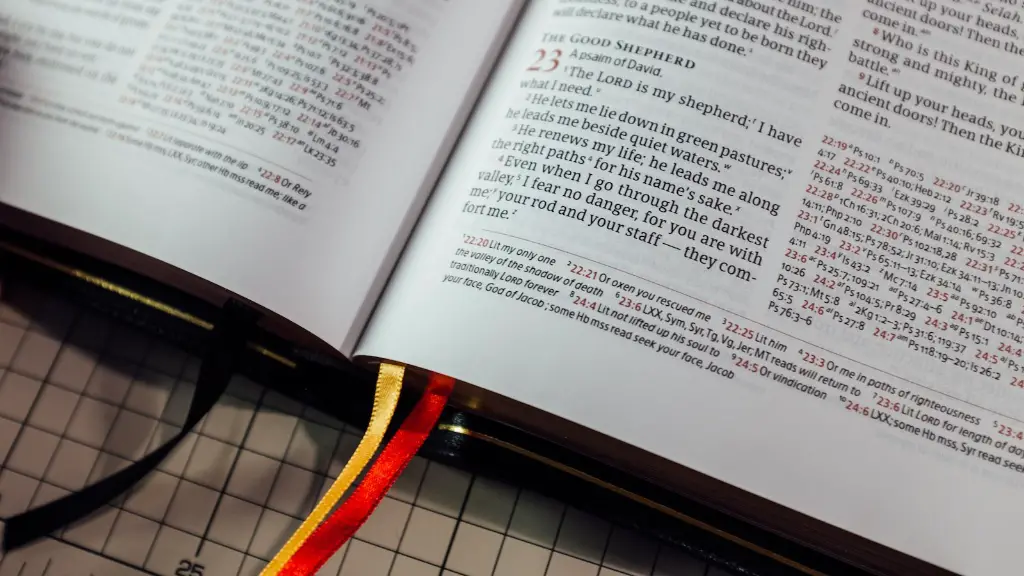Anyone who is familiar with the Bible knows that it has been translated into many languages, but how many English translations are there? That’s a more complicated question. To properly answer it, we must consider the different types of translations, the history of English translations, and the impact English translations have had on different groups of people.
In general, there are two broad categories of English translations used today: formal equivalence and dynamic equivalence. In formal equivalence, the translator seeks to transfer the meaning of the original text as accurately as possible by preserving elements such as the syntax, word order, and other nuances. In dynamic equivalence, the translator attempts to reproduce the meaning of the original in natural, everyday language that is easy for the modern reader to understand.
The history of English Bible translations goes all the way back to the Middle Ages. The earliest known translation of the Bible into English was made by John Wycliffe in 1382. Since then, there has been a steady stream of new English translations, spurred on by new discoveries, technological advances, and a changing understanding of the language. After Wycliffe’s translation, the most influential translation was the King James Version in 1611. The King James Version has been the most widely used translation for centuries, and is still in use today.
Since the invention of the printing press, English has become the dominant language of the Bible. This has had a profound impact on many cultures, as well as their religions. It has been used to spread the Christian faith to millions throughout the world, allowing them to access the teachings of the Bible in their native language. Additionally, it has had a significant impact on the English language. Many of the idioms, phrases, and expressions that make up the language today have their roots in the language of the Bible.
English translations of the Bible have also had a major impact on literature. Authors such as John Milton, William Shakespeare, and Thomas Hardy have all used the language of the Bible to shape and inform their own works. As a result, many English translations of the Bible are now considered to be literary classics in their own right.
So how many English translations are there of the Bible? The short answer is that it depends. There are multiple versions in circulation today, ranging from formal equivalence to dynamic equivalence. However, the King James Version continues to be the most widely used and influential. It is a testament to the power and influence of English translations, and of the Bible itself.
Impact on Culture
The impact of English translations of the Bible on culture is far-reaching. People have responded to Bible translations in a variety of ways, from rejecting them to embracing them. In some cases, people have interpreted the Bible in a way that has had a significant impact on their culture, such as in the case of the Puritans who embraced the Ten Commandments and used them as a basis for their laws. On the other hand, some cultures have responded to translations of the Bible by rejecting them and even imprisoning those who translated it.
English translations of the Bible have also had a major impact on the language itself. As the most widely used translation of the Bible, the King James Version has exerted a huge influence on the English language. Thousands of words, phrases, and expressions that we use today, such as “forgiveness”, “atonement”, and “righteousness”, all derive from the King James Version. Furthermore, due to its widespread use, English has become a global language. This has allowed people from diverse cultures and backgrounds to access the Bible from wherever they are in the world, without having to learn a new language.
Impact on Gender Equality
English Bible translations have had a tremendous impact on gender equality. In some cases, translations of the Bible have intentionally been used to promote a hierarchical view of gender roles, with men as the dominant figures and women as the submissive ones. However, in recent decades, a number of attempts have been made to create gender-inclusive translations of the Bible. These translations attempt to avoid language that is gender-biased, and to instead use gender-neutral language that is more reflective of the nuances of gender.
The impact of English translations of the Bible on gender equality is a complex issue. On the one hand, gender-inclusive translations have been beneficial in promoting the idea of gender equality. On the other hand, these translations may also lead to a “sameness” of language, as gender-neutral language may not always be appropriate in certain contexts. Additionally, some critics have argued that gender-inclusive translations strip the Bible of its poetic beauty, as gender-specific language is often used to communicate certain nuances that may be lost in a gender-neutral translation.
Impact on Our Faith
Many people around the world rely on English translations of the Bible to deepen their faith. Applying the Bible to everyday life can be difficult, however, as sometimes the original language of the Bible is obscure or difficult to interpret. This is where English Bible translations can be useful, as they provide a translation that is easier for modern readers to understand. By understanding the Bible in a language we are fluent in, we can gain a deeper understanding of its meaning and apply it to our lives more effectively.
English translations of the Bible have also had a major impact on how we interpret the Bible. English translations of the Bible allow us to access the Bible from different perspectives, and to interpret it in ways that are meaningful to us. This has enabled us to better understand the cultural and historical context of the Bible, as well as to interpret its messages in light of our own personal experiences.
English translations of the Bible have had a profound impact on our faith. By providing a translation that is easier for modern readers to understand, these translations make it possible for us to grow in our understanding of the Bible and to apply its teachings in our lives today.
Impact on Society
English translations of the Bible have had a tremendous impact on society as well. English translations of the Bible have been used to promote the spread of Christianity, to promote social justice, and to shape the moral perspectives of generations of readers.
For instance, English translations of the Bible have been used to shape how people view certain social issues. For example, the language of several English translations of the Bible have been used to promote a traditional view of marriage, with men as the heads of households and women as their subservient partners. Additionally, English translations of the Bible have been used to promote social justice, as the Bible is often interpreted to support the rights of the marginalized and disadvantaged.
English translations of the Bible have also had a significant impact on literature, art, and music. Many authors, composers, poets, and playwrights have drawn from the language and themes of the Bible to create works of art that reflect and express their faith. English Bible translations have been and continue to be used to inform and shape the collective consciousness of society, as they provide a common language and shared understanding of faith and morality.




